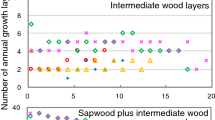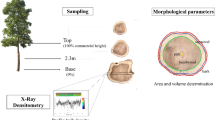Abstract
The formation and vertical distribution of sapwood and heartwood were studied with a 45-year-old Cryptomeria japonica D. Don. The tree was grown at a plantation with 1.5 m × 3.0 m spacing near Miao-Li, Taiwan and was felled on 27 February 1992. The thickness of sapwood and heartwood was expressed by a ring count and a linear measurement. The east-west (E-W) wood strips were collected from 0.3 m above ground upwards to the top of the tree at 2.5 m intervals. The sapwood thicknesses from the base to the 10.3 m tree level height are around 20–22 growth rings and 42±2 mm. At the top of the tree, the sapwood thickness is narrower. The heartwood, which decreases in thickness with increasing tree level heights is not found at the top of the tree. The heartwood appears as a conical shape in the tree trunk. There is no statistical difference in sapwood/heartwood thickness between E-W aspects. Tree level heights and the tree level age were found to be important parameters in determining the thickness of sapwood/heartwood.
Similar content being viewed by others
References
Bamber RK (1976) Comparative studies of sapwood and heartwood. PhD Thesis, Macquarie University Sydney, Australia
Bromely WS (1941) Sapwood in sugar maple trees. Pap Mich Acad Sci Arts Lett 27: 163–168
Büsgen M (1929) The structure and life of forest trees, 3rd revised edn by Munch (English translation). Chapman and Hall, London
Carrodus BB (1971) Carbon dioxide and the formation of heartwood. New Phytol 70: 939–943
Coyea M, Margolis HA, Gagnon RR (1990) A method for reconstructing the development of the sapwood area of balsam fir. Tree Physiology 6: 283–291
Frey-Wyssling A, Bosshard HH (1959) Cytology of the ray cells in sapwood and heartwood. Holzforschung 13: 129–137
Fukazawa K, Higuchi T (1965) Studies on the mechanisms of heartwood formation. Mokuzai Gakkaishi 11: 196–201
Grier CC, Waring RH (1974) Conifer foliage mass related to sapwood area. For Sci 20: 205–206
Harris JM (1954) Heartwood formation in Pinus radiata D. Don. New Phytol 53: 517–524
Harris JM, Orman HR (1958) The physical and mechanical properties of New Zealand grown Douglas-fir (Pseudotsuga taxifolia Britt.). NZ For Serv Tech Pap 24
Hazenberg G, Yang KC (1991a) The relationship of tree age with sapwood and heartwood width in black spruce, Picea mariana (Mill.) B. S. P. Holzforschung 45: 317–320
Hazenberg G, Yang KC (1991b) Sapwood/heartwood width relationships with tree age in balsam fir. IAWA Bulletin ns 12: 95–99
Hillis WE, Ditchburne N (1974) The prediction of heartwood diameter in radiata pine trees. Can J For Res 4: 524–529
Hugentobler UH (1965) Cytology of heartwood formation. Re-produced from Vierteljahrsschrift der Naturforschenden Gesellschaft in Zürich 110: 321–342 English translation. Foreign Language Division, Dept. of Secretary of State Bureau for Translation, No. 106, 1967, Ottawa
Ihara M (1972) A dendrometrical study on heartwood formation of forest tree. Bull Kyushu Univ Faculty of Agriculture, 46. Kyushu University Fukuoka, Japan
Kaufmann MR, Troendle CA (1981) The relationship of leaf area and foliage biomass to sapwood conducting area in four subalpine forest tree species. For Sci 27: 477–482
Lassen LE, Okkonen EA (1969) Sapwood thickness of Douglas-fir and five other western softwoods. USDA For Serv Res Pap FPL 124
Necesany V (1966) Changes in the vitality of parenchyma cells as the physiological basis of heartwood formation. Holzforsch Holzverwert 18: 61–65
Nelson ND (1976) Gross influence on heartwood formation in black walnut and black cherry trees. Resp Pap FPL For Prod Lab (U. S.) No 268
Nobuchi T, Kamizono Y, Harada H (1976) Cytological changes of parenchyma cells associated with heartwood formation on three softwood species; sugi (Cryptomeria japonica), Momi (Abies firma) and Akamatsu (Pinus densiflora). Bull Kyoto Univ For 48: 178–196
Paclt J (1953) Heartwood formation in beech. Phytopathol Z 20: 255–259
Panshin AJ, de Zeeuw C (1980) Textbook of wood technology, 4th edn. McGraw-Hill, Toronto, pp 24–30
Paul BH (1959) The effect of environmental factors on wood quality. Gen Tech Rep FPL US For Prod Lab Madison
Rogers R, Hinckley TM (1979) Foliar weight and area related to current sapwood area in oak. For Sci 25: 298–303
Rudman P (1966) Heartwood formation in trees. Nature 210: 608–610
Sellin A (1991) Variation in sapwood thickness of Picea abies in Estonia depending on the tree age. Scand J For Res 6: 403–469
Smith JH, Walters GJ, Wellwood RW (1966) Variation in sapwood thickness of Douglas fir in relation to tree and section characteristics. For Sci 12: 97–103
Stewart CM (1966) Excretion and heartwood in living trees. Science 153: 1068–1074
Trendelenburg R (1939) Das Holz als Rohstoff. Lehmanns, Berlin, pp 154–156
Wellwood RW, Jurazs PE (1968) Variation in sapwood thickness, specific gravity, and tracheid length in western red cedar. For Prod J 1891 20: 37–46
Whitehead D, Edwards WRN, Jurvis PG (1984) Conducting sapwood area, foliage area, and permeability in mature trees of Picea sitchensis and Pinus contorta. Can J For Res 14: 940–947
Wilkes J (1991) Heartwood development and its relationship to growth in Pinus radiata. Wood Sci Technol 25: 85–90
Wilkins AP (1991) Sapwood, heartwood and bark thickness of silvi-culturally treated Eucalyptus grandis. Wood Sci Technol 25: 415–423
Yang KC (1987) Metabolic activity of living sapwood ray cells in Picea mariana (Mill.) B. S. P. expressed by a new indicator. Can J Bot 65: 1775–1778
Yang KC (1990) The aging process of sapwood ray parenchyma cells in four woody species. Ph.D. dissertation, Faculty of Forestry, University of British Columbia, Vancouver, B. C.
Yang KC (1993) Survival rate and nuclear irregularity index of sapwood ray parenchyma cells in four different trees. Can J For Res 23: 673–679
Yang KC, Hazenberg G (1991a) Sapwood and heartwood width relationship to tree age in Pinus banksiana. Can J For Res 21: 521–525
Yang KC, Hazenberg G (1991b) Relationship between tree age and sapwood/heartwood width in Populus tremuloides Michx. Wood Fiber Sci 23: 247–252
Yang KC, Murchison HG (1992) Sapwood thickness in Pinus contorta var. latifolia. Can J For Res 22: 2004–2006
Yang KC, Hazenberg G, Bradfield GE, Maze JR (1985) Vertical variation of sapwood thickness in Pinus banksiana Lamb. and Larix laricina (Du Roi) K. Koch. Can J For Res 15: 822–828
Zimmerman MH, Brown CL (1971) Trees: structure and function. Springer, Berlin Heidelberg New York
Author information
Authors and Affiliations
Rights and permissions
About this article
Cite this article
Yang, K.C., Chen, Y.S., Chiu, C. et al. Formation and vertical distribution of sapwood and heartwood in Cryptomeria japonica D. Don. Trees 9, 35–40 (1994). https://doi.org/10.1007/BF00197867
Received:
Accepted:
Issue Date:
DOI: https://doi.org/10.1007/BF00197867




